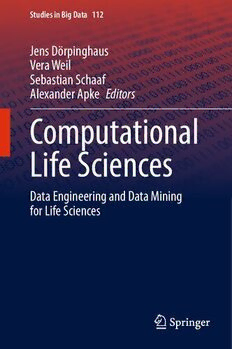Table Of ContentStudies in Big Data 112
Jens Dörpinghaus
Vera Weil
Sebastian Schaaf
Alexander Apke Editors
Computational
Life Sciences
Data Engineering and Data Mining
for Life Sciences
Studies in Big Data
Volume 112
SeriesEditor
JanuszKacprzyk,PolishAcademyofSciences,Warsaw,Poland
Theseries“StudiesinBigData”(SBD)publishesnewdevelopmentsandadvances
in the various areas of Big Data- quickly and with a high quality. The intent is to
coverthetheory,research,development,andapplicationsofBigData,asembedded
inthefieldsofengineering,computerscience,physics,economicsandlifesciences.
The books of the series refer to the analysis and understanding of large, complex,
and/or distributed data sets generated from recent digital sources coming from
sensorsorotherphysicalinstrumentsaswellassimulations,crowdsourcing,social
networks or other internet transactions, such as emails or video click streams and
other. The series contains monographs, lecture notes and edited volumes in Big
Data spanning the areas of computational intelligence including neural networks,
evolutionary computation, soft computing, fuzzy systems, as well as artificial
intelligence, data mining, modern statistics and Operations research, as well as
self-organizing systems. Of particular value to both the contributors and the
readership are the short publication timeframe and the world-wide distribution,
whichenablebothwideandrapiddisseminationofresearchoutput.
Thebooksofthisseriesarereviewedinasingleblindpeerreviewprocess.
IndexedbySCOPUS,EICompendex,SCIMAGOandzbMATH.
AllbookspublishedintheseriesaresubmittedforconsiderationinWebofScience.
· · ·
Jens Dörpinghaus Vera Weil Sebastian Schaaf
Alexander Apke
Editors
Computational Life Sciences
Data Engineering and Data Mining for Life
Sciences
Editors
JensDörpinghaus VeraWeil
FederalInstituteforVocationalEducation DepartmentforMathematicsandComputer
andTraining(BIBB) Science
Bonn,Germany UniversityofCologne
Cologne,Germany
GermanCenterforNeurodegenerative
Diseases(DZNE)
AlexanderApke
Bonn,Germany
DepartmentforMathematicsandComputer
Science
SebastianSchaaf
UniversityofCologne
GermanCenterforNeurodegenerative
Cologne,Germany
Diseases(DZNE)
Bonn,Germany
ISSN 2197-6503 ISSN 2197-6511 (electronic)
StudiesinBigData
ISBN 978-3-031-08410-2 ISBN 978-3-031-08411-9 (eBook)
https://doi.org/10.1007/978-3-031-08411-9
©TheEditor(s)(ifapplicable)andTheAuthor(s),underexclusivelicensetoSpringerNature
SwitzerlandAG2022
Thisworkissubjecttocopyright.AllrightsaresolelyandexclusivelylicensedbythePublisher,whether
thewholeorpartofthematerialisconcerned,specificallytherightsoftranslation,reprinting,reuse
ofillustrations,recitation,broadcasting,reproductiononmicrofilmsorinanyotherphysicalway,and
transmissionorinformationstorageandretrieval,electronicadaptation,computersoftware,orbysimilar
ordissimilarmethodologynowknownorhereafterdeveloped.
Theuseofgeneraldescriptivenames,registerednames,trademarks,servicemarks,etc.inthispublication
doesnotimply,evenintheabsenceofaspecificstatement,thatsuchnamesareexemptfromtherelevant
protectivelawsandregulationsandthereforefreeforgeneraluse.
Thepublisher,theauthors,andtheeditorsaresafetoassumethattheadviceandinformationinthisbook
arebelievedtobetrueandaccurateatthedateofpublication.Neitherthepublishernortheauthorsor
theeditorsgiveawarranty,expressedorimplied,withrespecttothematerialcontainedhereinorforany
errorsoromissionsthatmayhavebeenmade.Thepublisherremainsneutralwithregardtojurisdictional
claimsinpublishedmapsandinstitutionalaffiliations.
ThisSpringerimprintispublishedbytheregisteredcompanySpringerNatureSwitzerlandAG
Theregisteredcompanyaddressis:Gewerbestrasse11,6330Cham,Switzerland
Preface
Thelifescienceshavelongbeenconsideredadescriptive
science—10yearsago,thefieldwasrelativelydatapoor,and
scientistscouldeasilykeepupwiththedatatheygenerated.But
withadvancesingenomics,imagingandothertechnologies,
biologistsarenowgeneratingdataatcrushingspeeds.
—EmilySinger,2013
Inanutshell,thesewordsfromEmilySinger1describethestartingpointofourbook:
Nowadays, most life scientists have to handle enormous amounts of data. That is,
theymustbeabletousetechniquesandapplyadaptedtoolstotheirspecificproblem
athandinordertoapproachitssolution.Inotherwords,possessingandgenerating
(big) data is one thing, but the heart of the matter is to retrieve information out of
thisdata—efficientlyandreliably.
WhyLifeSciencesandData
Let’sleavethenutshell:Biologyisanexcitingfield,whichhasrecentlydeveloped
to what we call life sciences. On top of at least 500 years of exciting science and
development,lifesciencesfaceadditional,computer-relatedissues.Everydayand
world-wide,thefieldoflifesciencesischangingintermsofsoftware,algorithms,file
formatsandmuchmore.Regardingthis,togetherwiththealreadymentionedissue
of handling a great amount of rapidly increasing data, it is nearly unavoidable to
developandapplynew,efficient,robustandthusreliableheuristicsandalgorithms.
In other words, a lot of problems in life sciences and bioinformatics have to be
approached withalgorithmic solutions,presuming technical understanding and, of
1See https://www.wired.com/2013/10/big-data-biology/: Emily Singer: Biology’s Big Problem:
There’sTooMuchDatatoHandle,www.wired.com,10.11.2013.
v
vi Preface
course,biologicalexpertise.Thisappliestostudents,researchersandpracticioners
tothesameextent.Andhereliestheentrypointofourbook.
BookPurpose
Thepurposeofthisbookistoofferyoutheoreticalknowledgeaswellaspractical
adviceondiverseyetfundamentaltopicsofcomputationallifesciences.Thisencloses
at least a sketch (and often much more than this) of the theoretical foundations of
aspecificfieldaswellasthethereofevolvingpracticalaspects.Insomecases,this
leadsuptothepresentationofan(implemented)solutionfoundforaproblemthat
aroseinaspecificapplication.
Hence,everychapterofthisbookiseitherofhighpracticalrelevanceorofgreat
scientific interest, or both. If you are interested in Data Science and Life Sciences
ingeneral,ofifyouwanttoconsolidate your knowledge inthesetopics,ofifyou
are interested in applications and evolving technologies in this field or if you just
needaninspirationinordertoapproachyourownproblemathand,webelievethat
this book offers you a strong helping hand. Or, to make it short: We believe that
students,juniorandseniorresearchersbenefitfromthisbookaswellasteachersand
practitioners.
BookOverview
Thisbookisdividedintofiveparts.Thefirstpart,SolvingProblemsinLifeSciences:
OnProgrammingLanguagesandBasicConcepts,offersfoundationsondifferent
topics. Nowadays, issues being bound to a certain language are rare, hence the
first chapter considers the most common programming languages used in the Life
Sciences.ItcloseswithashortexplanationwhywechoseJavatoplayamainrole
in most of our examples. The first chapter is followed by an introduction to the
programminglanguageJava,includinginformationofusingcollaborativetoolslike
git.ThisintroductionoffersaquickstartguidetoJava,andcomesinhandwiththe
thirdchapter,BasicDataProcessing.Amongstothertopics,commondatastructures
andtheirusageaswellasapectsoftheobject-orientiedprogrammingparadigmare
introduced.ThepartcloseswiththechapterAlgorithmDesign,inwhichweconsider
themodelingofrealworldproblemsaswellasfundamentalalgorithmicprinciples.
Thesecondpart,DataMiningandKnowledgeDiscovery,startswithanintro-
ductorychapteronthemanagementofdataandknowledge.Thisisfollowedbythe
chapter on databases and how the contained information can be structured using
knowledge graphs. Applied statistics and AI approaches with regard to the appli-
cations in life sciences and medicine are the core elements of the third chapter. It
closeswithachapteronlongitudinaldata,thatis,roughlyspeaking,datarepeatedly
collectedoveranextendedperiodoftime.
Preface vii
ThethirdpartonDistibutedComputingandCloudsoffersinsightsoncompu-
tationalgridsaswellasoncloudcomputing.Bothofthesechaptersareflankedby
examples emerging from applications in the life sciences. The part closes with a
chapteronstandardswhichhelptocreateinteroperablesolutionsthatarethenable
tointeractwithothersolutionsusingthesamestandards.
Working and doing research in the life sciences often requires knowledge in
at least one of the following topics: graphs, optimiziation, image processing and
sequenceanalysis.Hence,inthefourthpart,AdvancedTopicsinComputational
LifeSciences,startswithachapterongraphsandhowtoimplementandusethem
with Java. It is followed by a chapter in which the fields of linear programs and
combinatorial optimization are illuminated. Images play a crucial role in the life
sciencesandmedicine,hencewededicatedthethirdchaptertoimageprocessingand
imagemanipulation.Weclosethefourthpartwithachapteronsequenceanalysis,an
almostclassicalfieldintheareaoflifesciencesandastandardexamplethatshows
theconnectionbetweenthedecodingofDNA-sequencesandtextminingproblems
incomputerscience.
Asoneofthekeyfeatures,inthelastpartofthebook,ApplicationsandEmerging
Technologies,youwillalsofindsomemoresophisticatedapplicationsarisingfrom
scientific projects. These do not only show interesting results but might also be
helpfulguidelinesforyourownupcomingprogrammingproject.
Contributors
Especiallythecreationoflastpartofthebookcouldonlybeaccomplishedbythehelp
ofthemanycontributorsthatauthoredthosechapters.Youwillfindtherespective
authorslistedatthebeginningofeach.Further,alsointheotherpartsofthisbook
youwillfindsomechapterswrittenbyadditionalcontributors.Wheneverthisisthe
case,thosecontributorsarementionedexplicitlyatthebeginningoftheaccording
chapter.Allthechapterswithnoexplicitlymentionedauthorsarecontributedbythe
editors. Thanks to this variety of contributors and their scientific background, you
willfindawiderangeofdifferentstylesofwritingandthematicfocussesthroughout
this book. This leads to a rather dynamic than monotonous ductus that hopefully
makes it even more fun to read. We would like to thank all these authors that all
contributedasignificantpartofthisbook.
Acknowledgements
Weacknowledgethemanypeoplethathelpedtoimprovethisbook.Itisourpleasure
to explicitly mention Christof Meigen and Dr. Wolfgang Ziegler who played an
importantrole.Inaddition,wethankallstudentsfromourteachingattheUniversities
of Cologne and Bonn that helped to improve the quality of several chapters, in
viii Preface
particular Regina Wehler, Colin Birkenbihl and Olivier Morelle. We would like to
extendourthankstoSpringer—fortheirhelpandpatiencethroughthepublication
processofthisbook.
Thisworkisdedicatedtoourfamiliesandchildren.
Cologne,Germany AlexanderApke
Bonn,Germany JensDörpinghaus
Bonn,Germany SebastianSchaaf
Cologne,Germany VeraWeil
January2021
Contents
SolvingProblemsinLifeSciences:OnProgrammingLanguages
andBasicConcepts
InterestingProgrammingLanguagesUsedinLifeSciences ............ 3
ChristofMeigen
IntroductiontoJava ............................................... 21
JensDörpinghaus,VeraWeil,SebastianSchaaf,andAlexanderApke
BasicDataProcessing .............................................. 55
JensDörpinghaus,VeraWeil,SebastianSchaaf,andAlexanderApke
AlgorithmDesign .................................................. 79
AlexanderApke,VeraWeil,JensDörpinghaus,andSebastianSchaaf
DataMiningandKnowledgeDiscovery
DataandKnowledgeManagement .................................. 101
ChristofMeigen,JensDörpinghaus,VeraWeil,SebastianSchaaf,
andAlexanderApke
DatabasesandKnowledgeGraphs .................................. 121
TobiasHübenthal
KnowledgeDiscoveryandAIApproachesfortheLifeSciences ........ 183
AlexanderApke,VeraWeil,JensDörpinghaus,andSebastianSchaaf
LongitudinalData ................................................. 231
ChristofMeigen
DistributedComputingandClouds
ComputationalGrids .............................................. 247
WolfgangZiegler
ix

